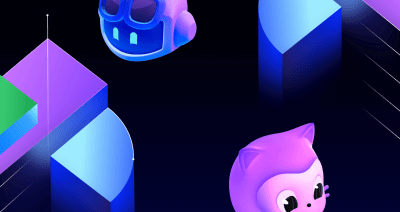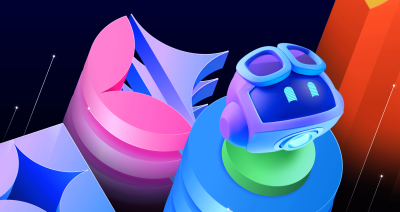What developers need to know about generative AI
Generative AI has been dominating the news lately—but what exactly is it? Here’s what you need to know, and what it means for developers.

By now, you’ve heard of generative artificial intelligence (AI) tools like ChatGPT, DALL-E, and GitHub Copilot, among others. They’re gaining widespread interest thanks to the fact that they allow anyone to create content from email subject lines to code functions to artwork in a matter of moments.
This potential to revolutionize content creation across various industries makes it important to understand what generative AI is, how it’s being used, and who it’s being used by. In this article, we’ll explore what generative AI is, how it works, some real-world applications, and how it’s already changing the way people (and developers) work.
What is generative AI used for?
You may have heard the buzz around new generative AI tools like ChatGPT or the new Bing, but there’s a lot more to generative AI than any one single framework, project, or application.
Traditional AI systems are trained on large amounts of data to identify patterns, and they’re capable of performing specific tasks that can help people and organizations. But generative AI goes one step further by using complex systems and models to generate new, or novel, outputs in the form of an image, text, or audio based on natural language prompts.
Generative AI models and applications can, for example, be used for:
- Text generation. Text generation, as a field, with AI tools has been in development since the 1970s—but more recently, AI researchers have been able to train generative adversarial networks (GANs) to produce text that models human-like speech. A prime example is OpenAI’s application ChatGPT, which has been trained on thousands of texts, books, articles, and code repositories, and can respond with full answers to natural language prompts and questions.

- Image generation. Generative AI models can be used to create new images with natural language prompts, which is one of the most popular techniques with current tools and applications. The goal with text-to-image generation is to create an image that accurately represents the content of a given prompt. For example, when we give the text prompt, “impressionist style oil painting of a Shiba Inu dog giving a tarot card reading,” to the popular AI image generator DALL-E 2 we get something that looks like this (and yes, it’s a gem):

- Video generation. Generative AI models, like Stable Diffusion, are creating new videos from existing videos by applying specified styles through a text prompt or image reference. One project on GitHub, stable-diffusion-videos, offers helpful examples and tips on how to create music videos and videos that can morph between text prompts with Stable Diffusion.
.](https://github.blog/wp-content/uploads/2023/04/image3.gif)
- Programming code generation. Rather than scouring the internet or developer community groups for help with code examples, generative AI models can be used to help generate new programming code with natural language prompts, complete partially written code with suggestions, or even translate code from one programming language to another. This is how, at a simple level, GitHub Copilot works: it uses OpenAI’sCodex model to offer code suggestions right from a developer’s editor. However, as you would with any software development tool, we encourage you to review generated code before merging into production.
-
Data generation. Creating new data—which is called synthetic data—and augmenting existing data sets is another common use case for generative AI. This involves generating new samples from an existing dataset to increase the dataset’s size and improve machine learning models trained on it, all while providing a layer of privacy since real user data is not being utilized to power models. Synthetic data generation provides a way to create useful, meaningful data for more than just ML training though—a number of self-driving car companies like Cruise and Waymo utilize AI-generated synthetic data for training perception systems to prepare vehicles for real-world situations while in operation.
-
Language translation. Natural-language understanding (NLU) models combined with generative AI have become increasingly popular to provide language translations on-the-fly. These types of tools help companies break language barriers and increase their scope of accessibility for customer bases by being able to provide things like support or documentation in their native language. Through complex, deep learning algorithms, generative AI is able to understand the context of a source text and linguistically construct those sentences in another language. This practice can also apply to coding languages, for example, translating a desired function from Python to Java.
The bottom line: Even though generative AI is a relatively new technology, it’s already being used in consumer and business applications. The use cases, as well as the quantity of applications created with it, will continue evolving to meet more distinct and specific needs.
How does generative AI work?
Generative AI models work by using neural networks to identify patterns from large sets of data, then generate new and original data or content.
But what are neural networks? In simple terms, they use interconnected nodes that are inspired by neurons in the human brain. These networks are the foundation of machine learning and deep learning models, which use a complex structure of algorithms to process large amounts of data such as text, code, or images. Training these neural networks involves adjusting the weights or parameters of the connections between neurons to minimize the difference between predicted and desired outputs, which allows the network to learn from mistakes and make more accurate predictions based on the data.
Algorithms are a key component of machine learning and generative AI models. But beyond helping machines learn from data, algorithms are also used to optimize accuracy of outputs and make decisions, or recommendations, based on input data.
While algorithms help automate these processes, building a generative AI model is incredibly complex due to the massive amounts of data and compute resources they require. People and organizations need large datasets to train these models, and generating high-quality data can be time-consuming and expensive.
To restate the obvious, these models are complicated. Need proof? Here are some common generative AI models and how they work:
- Large language models (LLM): LLMs are a type of machine learning model that process and generate natural language text. One of the most significant advancements in the development of large language models has been the availability of vast amounts of text data, such as books, websites, and social media posts. This data can be used to train models that are capable of predicting and generating natural language responses in a variety of contexts. As a result, large language models have multiple practical applications, such as virtual assistants, chatbots, or text generators, like ChatGPT.
-
Generative adversarial networks (GAN): GANs are one of the most used models for generative AI, and they employ two different neural networks. GANs consist of two different types of neural networks: a generator and a discriminator. The generator network generates new data, such as images or audio, from a random noise signal while the discriminator is trained to distinguish between real data from the training set and the data produced by the generator.
During training, the generator tries to create data that can trick the discriminator network into thinking it’s real. This “adversarial” process will continue until the generator can produce data that is totally indistinguishable from real data in the training set. This process helps both networks improve at their respective tasks, which ultimately results in more realistic and higher-quality generated data.
 האדם-החושב on wikipedia](https://github.blog/wp-content/uploads/2023/04/image4-1.png?w=1024&resize=1694%2C740)
- Transformer-based models: A transformer-based model’s neural networks operate by learning context and meaning through tracking relationships of sequential data, which means these models are really good at natural language processing tasks like machine translation, language modeling, and answering questions. These models have been used in popular language models, such as GPT-4 (which stands for Generative Pre-trained Transformer 4), and have also been adapted for other such tasks that require the modeling of sequential data such as image recognition.
- Variational autoencoder models (VAEs): These models are similar to GANs in that they work with two different neural networks: encoders and decoders. VAEs can take a large amount of data and compress it into a smaller representation, which can be used to create new data that is similar to the original data. VAEs are often used in image, video, and audio generation—and here’s a fun fact: you can train a VAE on datasets like CelebA, which contains over 200,000 images of celebrities, to create completely new portraits of people that don’t exist.
 using VAEs trained on the CelebA dataset.](https://github.blog/wp-content/uploads/2023/04/image6.jpg?w=539&resize=539%2C220)
The real-world applications of generative AI
The impact of generative AI is quickly becoming apparent—but it’s still in its early days. Despite this, we’re already seeing a proliferation of applications, products, and open source projects that are using generative AI models to achieve specific outcomes for people and organizations (and yes, developers, too).
Though generative AI is constantly evolving, it already has some solid real world applications. Here’s just a few of them:
Coding
New and seasoned developers alike can utilize generative AI to improve their coding processes. Generative AI coding tools can help automate some of the more repetitive tasks, like testing, as well as complete code or even generate brand new code. GitHub has its own AI-powered pair programmer, GitHub Copilot, which uses generative AI to provide developers with code suggestions. And GitHub also has announced GitHub Copilot X, which brings generative AI to more of the developer experience across the editor, pull requests, documentation, CLI, and more.
Accessibility
Generative AI has the potential to greatly impact and improve accessibility for folks with disabilities through a variety of modalities, such as speech-to-text transcription, text-to-speech audio generation, or assistive technologies. One of the most exciting facets of our GitHub Copilot tool is its voice-activated capabilities that allow developers with difficulties using a keyboard to code with their voice. By leveraging the power of generative AI, these types of tools are paving the way for a more inclusive and accessible future in technology.
Gaming
Generative AI can take gaming to the next level (get it? 😉) by generating new characters, storylines, design components, and more. Case in point: The developer behind the game, This Girl Does Not Exist, has said that every component of the game—from the storyline to the art and even the music—was generated entirely by AI. This use of generative AI can enable gaming studios to create new and exciting content for their users, all without increasing the developer workload, which frees them up to work on other aspects of the game, such as story development.
Web design
Designers can utilize generative AI tools to automate the design process and save significant time and resources, which allows for a more streamlined and efficient workflow. Additionally, incorporating these tools into the development process can lead to the creation of highly customized designs and logos, enhancing the overall user experience and engagement with the website or application. Generative AI tools can also be used to do some of the more tedious work, such as creating design layouts that are optimized and adaptable across devices. For example, designers can use tools like designs.ai to quickly generate logos, banners, or mockups for their websites.
Web search
Microsoft and other industry players are increasingly utilizing generative AI models in search to create more personalized experiences. This includes query expansion, which generates relevant keywords to reduce the number of searches. So, rather than the search engine returning a list of links, generative AI can help these new and improved models return search results in the form of natural language responses. Bing now includes AI-powered features in partnership with OpenAI that provide answers to complex questions and allow users to ask follow-up questions in a chatbox for more refined responses.
Healthcare
Interest has emerged around the potential applications of generative AI in the healthcare field to improve disease detection and diagnosis, advance medical research, and accelerate progress in the pharmaceutical space. Potentially, generative AI could be used to analyze large amounts of data to simulate chemical structures and predict new compounds will be the most effective for new drug discoveries. NVIDIA Clara is one example of a generative AI model specifically designed for medical imaging and healthcare research. (Plus, Gartner suggests more than 30 percent of new pharmaceutical drugs and materials will be discovered via generative AI models by 2025.)
Fun fact: Did you know that ChatGPT recently passed the US Medical Licensing exam without any intervention from clinicians?
Marketing and advertising
In marketing, content is king—and generative AI is making it easier than ever to quickly create large amounts of it. A number of companies, agencies, and creators are already turning to generative AI tools to create images for social posts or write captions, product descriptions, blog posts, email subject lines, and more. Generative AI can also help companies personalize ad experiences by creating custom, engaging content for individuals at speed. Writers, marketers, and creators can leverage tools like Jasper to generate copy, Surfer SEO to optimize organic search, or albert.ai to personalize digital advertising content.
Art and design
As we’ve seen above, the power of AI can be harnessed to create some incredible portraits in a matter of moments (re: the future-telling Shiba 🐕). Artists and designers alike are using these AI tools as a source of inspiration. For example, architects can quickly create 3D models of objects or environments and artists can breathe new life into their portraits by using AI to apply different styles, like adding a Cubist style to their original image. Need proof? Designers are already starting to use AI image generators, such as Midjourney and Microsoft Designer, to create high-quality images by simply typing out Discord commands.
Finance
In a recent discussion about tech trends and how they’ll affect the finance sector, Michael Schrage, a research fellow at the MIT Sloan School Initiative on the Digital Economy, said, “I think, increasingly, we’re going to be seeing generative AI used for financial forecasts and scenario generation.” This is a likely path forward—generative AI can be used to analyze large amounts of data to detect fraud, manage risk, and inform decision making. And that has obvious applications in the financial services industry.
Manufacturing
Manufacturers are starting to turn to generative AI solutions to help with product design, quality control, and predictive maintenance. Generative AI can be used to analyze historical data to improve machine failure predictions and help manufacturers with maintenance planning. According to research conducted by Capgemini, more than half of European manufacturers are implementing some AI solutions (although so far, these aren’t generative AI solutions). This is largely because the sheer amount of manufacturing data is easier for machines to analyze at speed than humans.
AI as a partner: Generative AI models and tools are narrow in focus, and work best at generating content, code, and images. In research at GitHub, we’ve found that GitHub Copilot helps developers code up to 55% faster, underscoring how generative AI models and tools can improve overall productivity and boost efficiency. Metrics like these show how generative AI tools are already changing how people and teams work—but they also underscore how these tools act as complement to human efforts.
Take this with you
Whether it’s creating visual assets for an ad campaign or augmenting medical images to help diagnose diseases, generative AI is helping us solve complex problems at speed. And the emergence of generative AI-based programming tools has revolutionized the way developers approach writing code.
We know that developers want to design and write software quickly, and tools like GitHub Copilot are enabling them to access large datasets to write more efficient code and boost productivity. In fact, 96% of developers surveyed reported spending less time on repetitive tasks using GitHub Copilot, which in turn allowed 74% of them to focus on more rewarding work.
While these models aren’t perfect yet, they’re getting better by the day—and that’s creating an exciting immediate future for developers and generative AI.
Tags:
Written by
Related posts

From chaos to clarity: Using GitHub Copilot agents to improve developer workflows
Explore how you can set Copilot coding agent up for success with custom instruction and Copilot setup steps.

Code review in the age of AI: Why developers will always own the merge button
When it comes to merging code, developers will always make the final decision. But we’re rethinking how tools like GitHub Copilot can help.

Beyond prompt crafting: How to be a better partner for your AI pair programmer
Ensuring quality code suggestions from Copilot goes beyond the perfect prompt. Context is key to success when working with your AI pair programmer.
